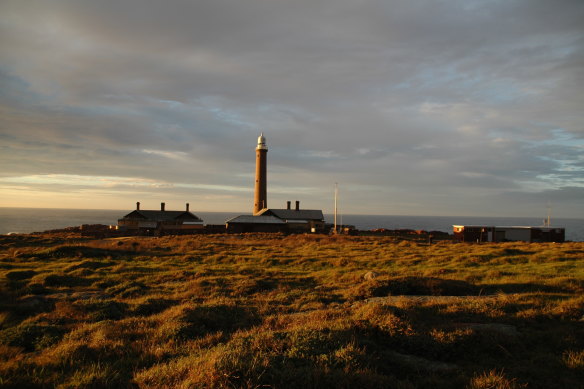This was published 4 years ago
Seabirds, salt-spray and shipwrecks: Gabo Island casts its spell
By Jane Cadzow
I first went to Gabo Island on assignment, to write a story about a day in the life of a lighthouse keeper. I was in my 20s, and at a loss to understand why anyone would choose to lead such an isolated existence. Gabo lies off the far eastern coast of Victoria, where the Tasman Sea meets the treacherous waters of Bass Strait. The 15-kilometre flight from the town of Mallacoota takes only a few minutes, but once you touch down on the grassy airstrip, there’s a sense of complete separation from the outside world. Though the lighthouse keeper and his wife were hospitable, I was pleased I was staying only 24 hours.

Gabo Island, a windswept outpost. Its lighthouse, now fully automated, is the second tallest in Australia. Credit: Parks Victoria
When next I visited, again for work, the lighthouse had been fully automated and the 154-hectare island’s sole permanent resident was a caretaker. This time I was writing about Alexandra Lyall, a Victorian artist on a quest to unravel a family tragedy. Alex’s grandfather had been the assistant lighthouse keeper in the 1920s and had committed suicide by drinking poison after his 34-year-old wife died from a mysterious illness. Alex herself had been diagnosed with advanced breast cancer at the age of 34, and she suspected that her grandmother may have had the same disease.
By the time I got to Gabo, Alex had been there for weeks, mulling over the past and working on a series of paintings of the lighthouse. We went for walks – Alex talking intently while I shivered because I hadn’t brought a proper coat (it was December; I hadn’t thought I’d need one). She was such a big personality, so warm and exuberant, that her fascination with the island and its history rubbed off on me. Long after my story was filed, I found myself thinking about that windswept outpost at the south-east corner of the continent. I wanted to return.
Then, as now, Parks Victoria offered accommodation in the assistant lighthouse keeper’s cottage.
I booked for eight people – two couples, four kids – and hoped it wasn’t completely insane to be going in midwinter. Alex emailed a list of things to take. Starting with “Your coat, Jane!”, it included wet-weather gear, beanies, gloves, binoculars (for whale-watching) and torches. The list ended with “Wine (must be red)” and “Whisky (must be Scotch) for when you return from those freezing penguin-spotting walks”. Alex added: “PS I’m feeling excellent! My doctor is increasingly confident that the drug is working for me.”
We packed a picnic and roamed for hours, following a track through banksia and honey myrtle.
The afternoon we arrived, the ocean roiled and clouds scudded. We braced against icy gusts that felt like they had blasted straight from the Antarctic. I remember wondering whether the smaller children might actually blow away. The wildness was exhilarating, as was the fact that, apart from the caretaker, we were quite alone, with an entire island to ourselves.
The next day dawned clear and still. We packed a picnic and roamed for hours, following a track through a central forest of banksia and giant honey myrtle, exploring the cliffs, rocky coves and small, sandy beaches. We paused at a monument erected in memory of the more than 30 people who died when the steamer Monumental City ran aground in a gale in 1853. That and other shipwrecks spurred the construction of the red granite lighthouse, which, at 47 metres, is the second tallest in Australia (after the lighthouse at Cape Wickham, on King Island). We clattered up its cast iron steps and gazed to the blue horizon.

Little penguins on Gabo Island. "Just as it seemed they were never going to appear, there they were, dozens and dozens of them." Credit: Getty Images
Gabo has one of the world’s largest known breeding colonies of little penguins. We sat above the beach in the gathering darkness and waited – and waited – for the penguins to make their evening landfall. Just as it seemed they were never going to appear, there they were, dozens and dozens of them, swimming in the shallows then waddling ashore and skittering in all directions to their burrows. As we made our way by torchlight back to the cottage, I glanced up at the sky, which was huge and star-spangled. Though Alex had recommended whisky, I popped the cork on a bottle of champagne.
Alex died in 2007, aged 52. By then I had bought one of her oil studies of the interior of the lighthouse tower, looking downwards into the vortex of the spiral staircase. It is a dark, edgy picture – like a still from Alfred Hitchcock’s Vertigo, someone said – but it always lifts my spirits because it transports me back to Gabo. When I look at it, I can almost hear the cry of seabirds and the sound of crashing waves, and feel the tingle of salt-spray on my skin.
To read more from Good Weekend magazine, visit our page at The Sydney Morning Herald, The Age and Brisbane Times.